Ethiopian History: The revisionists now want to skew the details on slavery—don’t let them
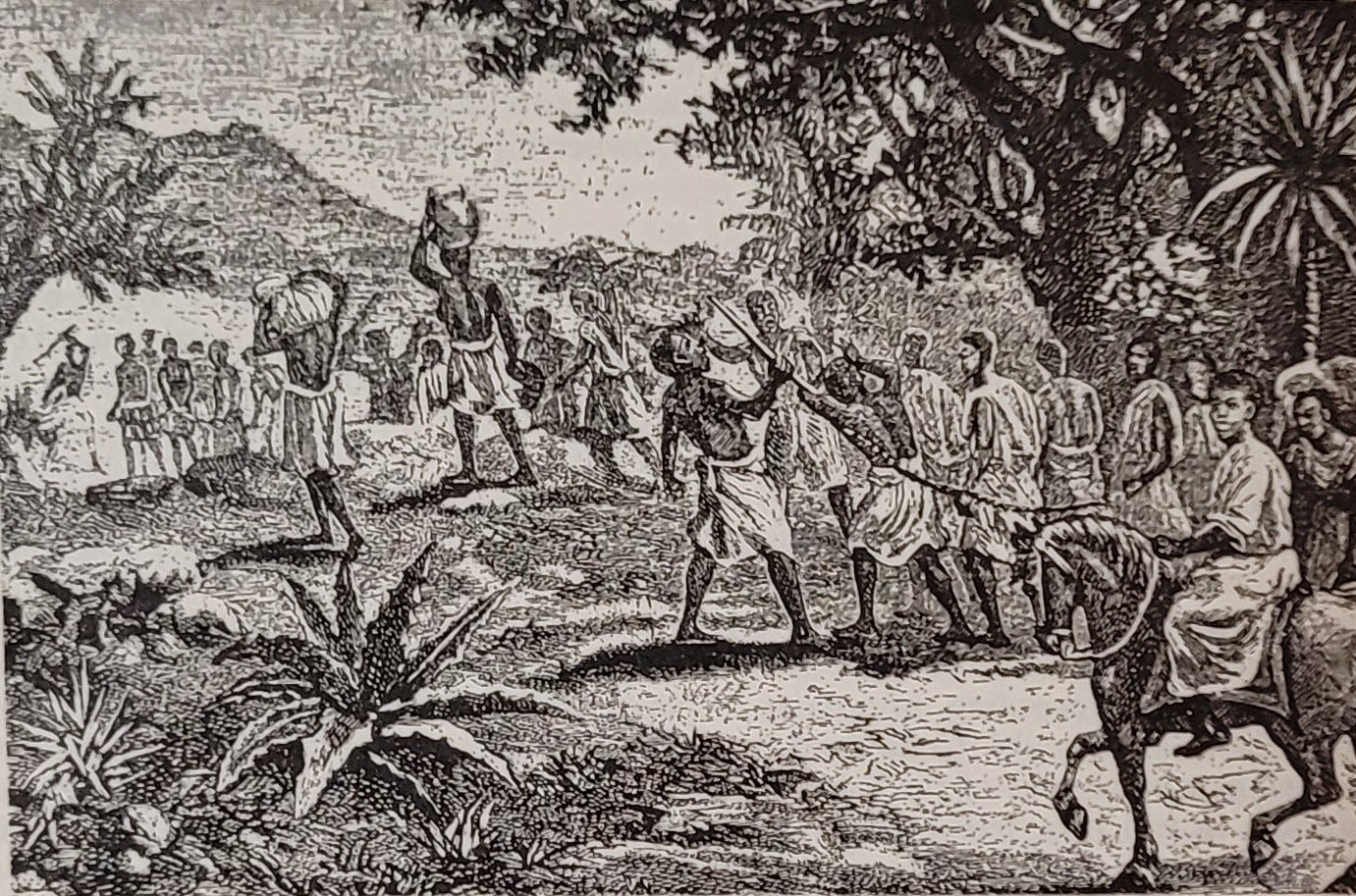
There is a very silly video put out on YouTube a few days ago (and no, I won’t link to it and give this person the traffic) that wants to play the shame game for Ethiopia over slavery.
And of course, its comments section is full of effusive praise by people who clearly can’t be bothered to read, to actually go and verify what the hell this person is saying. She blathers on about her views, mentions her mother, complains about some creep threatening her on Reddit, which yes, is objectively terrible, and to her credit, she does bother to cite a couple of sources, including Sandra Rowoldt Shell’s Children of Hope, which Ethiopian revisionists just love, and the Fetha Nagast.
It is such a rambling talk about the subject that it hardly needs a point-by-point critique. And of course, the person presents themselves coherently and persuasively enough that you almost buy the message. But everything is context, and you should be suspicious when you discover this same individual has peddled the destructive nonsense of “Tigrayan genocide” in another video and more recently has gone on the X social platform to push the batshit crazy nonsense that Egypt “colonized” Ethiopia simply because the Aksumite Empire adopted the Orthodox Christian Church. Really? Really?
Well, if you want to play that game, I guess we should also pretend the Pope “colonized” France and Germany and England, and please get out of here with this rubbish…
This person wants very badly to tie the history of slavery to the “Abyssinian Empire.” (Once again, the revisionists’ pet term which Ethiopian royalty never used; it was only used by Westerners.) And she wants to link slavery to colorism. Now this is where this person just brazenly indulges in bullshit…
Because guess what? 1) It wasn’t simply the Ethiopian empire that was capturing and selling slaves but she never bothers to differentiate the eras involved and spends most of her time talking about the 19th and 20th centuries; 2) Given that we know for a fact it wasn’t just the empire but also Oromo communities and kingdoms capturing people and making them slaves, that kind of blows a big hole in the colorism argument, doesn’t it?
But is she then totally wrong about colorism being an ugly issue in Ethiopia? She’s not.
Menelik himself was sneered at by certain people, both white and Black, because of his features, such as his nose and thick lips. Hubert Julian, the con-man “Black Eagle” whom to this day still has his lies recycled by lazy feature writers as truth, was apparently heckled by Ethiopians in 1935 as Shankala Nrs or “N— Eagle.” The crude slur was prompted by the fact that he was a dark-skinned Black man.
Nor is she completely wrong about a link between colorism and slavery. She just doesn’t bother to tell the whole story. But we’ll get to that.
Buckle in, folks, this is a long one, but hopefully it’ll be worth it.
The thing that is so obvious it shouldn’t have to be stated is that of course, slavery is wrong (is because it’s tragically still around in other parts of the world). And yes, African slavery, which is closer to indentured servitude, doesn’t quite dig you out of the morality hole. But this is where I as a historian and any Ethiopian, let alone any Ethiopian patriot, have a right to get pissed off.
You can’t simply view past events through today’s righteous indignations and moral litmus tests. Nor should you be weaponizing history for an agenda.
The revisionists and the propagandists are keen to pick on Ethiopia’s empire while letting others off the hook and never mentioning them. As with the TPLF victim narrative, they seem to think if they just keep banging on over and over, they can undermine appreciation of a country’s culture. That’s the obvious goal.
It’s a comically stupid one. Consider that my own country, Canada, had slavery. Of course, we did—we were part of the British Empire. What do I lose by acknowledging that truth? Nothing. I’m the descendant of the most destructive assholes in the world who went around the globe not only marking territory in red for their imperial map but also painting the world red in blood. What do I lose by conceding this fact? Nothing.
Just don’t lie to me about my history. Or to Ethiopians about their own. Don’t push half-truths and bullshit narratives.
And because I keep seeing bullshit recycled and cynically peddled, I think it’s necessary to set the record straight.
Those who really want to know the facts on Ethiopian slavery can take some comfort in that the revisionists are often lazy. Even Shell’s book, Children of Hope, has only a single line acknowledging the Oromo Migration and even then treats it as if it’s not an established fact, ignoring the narrative left to us by the chronicler of the early Oromo, Bahrey. Nor does Shell seem to care that the Oromo had more than just gada communities but individual monarchies of their own co-existing outside and within the Ethiopian empire. But we’ll touch on that in a bit.
Meanwhile, you still run across idiots who cite , who wouldn’t know Ethiopian history if an Aksum obelisk fell over on him. “Histories of the country gloss over slavery,” claims Harter. Except they don’t. Whole sections are devoted to the topic in Richard Pankhurst’s two thick volumes on Ethiopia’s economy (his second one covered in meticulous detail the numbers exported, slave conditions, and the extent of the trade). Harold Marcus wrote about it, as did Bahru Zewde, as did others.
Rather than quote from published sources on the subject, Harter includes hearsay anecdotes from a couple of ordinary folks born decades after slavery was abolished, and he writes this ridiculous line: “Historical data on the slave trade is patchy.” Again, no, it isn’t—it’s only patchy if you’re a lazy hack who doesn’t bother to do your homework. So, let’s actually dig in.
Early Slavery
There is no getting around that slavery is baked right into the true historical narrative. The two young Phoenician boys so critical to Ethiopia starting on its path to Christianity, Aedesius and Frumentius, were originally brought to Aksum’s King Ousanas as slaves. The early Christian empire seemed to have little issue with Muslim caravans carting off slaves for sale in the Middle East while they brought in precious salt from the Danakil.
And yes, slavery is discussed in the Fetha Nagast…. yawn, big deal. You can find equally damning, embarrassing stuff in the King James Bible or the Koran. So what? If anything, the Fetha Nagast undermines the colorism argument because it states quite bluntly, “The sale of a believing slave to an unbeliever is not allowed.” In other words, you can’t sell a Christian to a non-Christian. As in Europe, the obsession of the Middle Ages was faith, not skin tone.
But again, if we’re going to pick on the Ethiopian Empire in the time of Sarsa Dengel and the 16th century, which is the era when the Fetha Nagast really came into use, why aren’t we complaining about the emir of Harar, Mahfuz, who captured 19,000 Ethiopians and sold them into Middle East slavery? Why don’t we talk about the slave raids of Ahmad Gran? It’s also interesting that anti-Ethiopian revisionists forget how a major market for Ethiopian slaves besides the Middle East was India, particularly Gujaret.
And yet India was one of the cultures that helped inspire architectural design in Ethiopia. And some Ethiopian slaves who wound up in India rose to astonishingly impressive positions of power, such as the warlord Malik Ambar. (And why this guy doesn’t have his own big budget Hollywood epic film is a mystery. Forget the silliness of the Gladiator franchise, gimme a film about Malik—patron of the arts, guerrilla warfare expert, kick-ass underdog.)
But most of all… why aren’t we talking as well about the Oromo kingdoms and communities that ruthlessly invaded the imperial lands and took slaves in the 16th century? Or those that practiced slavery and sold slaves even while affiliated with or were part of the imperial confederation in the centuries after?
We can venture a guess. Because the revisionists attacking the Ethiopian empire often have another target in mind, though they sometimes don’t spell it out. It’s the Amhara, who are repeatedly—and wrongly—claimed to have “dominated” the empire. I’ve , pointing that out that multiple ethnicities all collaborated with each other as much as they competed to build a nation.
The bottom line is that you’ve got plenty of culpability to spread around over slavery, whether you want to talk about the slaves of the Aksumites in what became Tigray or the slaves working under the Yeju Dynasty, when—surprise!—the most important emperors and their key insiders were Oromo.
How easily these other slaveowners and slave-dealers get forgotten because the agenda is to undermine the cultural legitimacy of a country’s past. Sorry, but again, let’s say it loud: the truth was more complex. We can see one showcase of that in the royal edict—likely issued in 1548—of Galawdewos on slavery. He declared:
“I, King Galawdewos, son of Wanag Sagad, have ordered that from now onwards any merchant [traveling with slaves], whether he be Muslim or Christian, shall not proceed to the sea, to Adal, and to other market places visited by merchants, without coming to my gate [for inspection]. Let him bring both female and male slaves before me…”
As in the Fetha Nagast, the concern here was to protect only Christian slaves. But Galawdewos owned slaves himself. Whether he wanted to make life difficult for the Adal Sultanate or he was simply outraged, his beef here with the slave trade was that it took his Christian subjects out of his country, handing them over to Arab or Muslim non-believers.
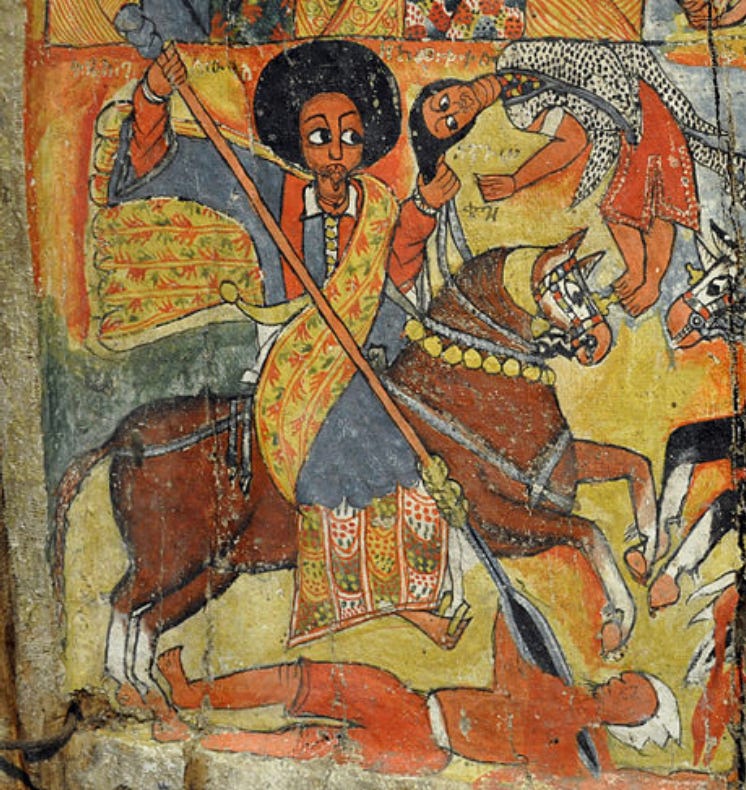
Nevertheless, there are several important aspects to this edict. You can tell right from the opening line that the onus was on merchants to prove they had a legal right to their human cargo. They needed to provide a detailed list of slaves and the original purchase price for each; if a slave wasn’t on the record and turned out to be a Christian, the dealer could be executed! And the edict itself is remarkable in that it demonstrates a royal commitment to backing up the law with inspectors and courts. We don’t know how well Galawdewos’s edict was enforced, and the slave trade certainly went on long after he was gone. But—
This is a legal milestone, not only for Ethiopia but for all of Africa.
Remember that to the medieval emperors, being a Christian was the highest you rated on the citizenship scale; Galawdewos believed he was rescuing his own citizens. Contrary to myth about African acquiescence, there were West African kings who bitterly resented the slave trade and lobbied European authorities to stop raiding their nations. And here is the edict of Galawdewos that gives us a written example where a king took punitive measures against those within his own realm.
The edict is far from perfect, but there, enshrined right in the document, were the penalties if slavers defied his command. And this was around 1548. Now consider that the British Empire didn’t abolish its end of the transatlantic slave trade until 1807, and to get this done, it compensated slave owners for their losses.
Tewodros makes an effort
There are many Ethiopians who are fans of Tewodros II. I’m not one of them. I think he had some good ideas and noble goals for reform, but often the only method he used to enforce his plans was sadistic violence. And the fact that he had a whole bunch of innocent Ethiopians thrown off a cliff right before he defended Magdala doesn’t make him cuddlier. It always struck me as ironic that there’s a big golden statue of him in the main roundabout of Gondar, but he sacked Gondar twice.
Still, Tewodros had a genuine contempt for slavery. He permitted Christians to buy slaves, but only if they would free them; he personally bought slaves himself from Muslim dealers for this purpose. The flaw in this scheme was that it only kept the trade going, a criticism fired at human rights groups more than a century later who tried to free and then emancipate slaves in modern Sudan.
A Swiss missionary, Theophilius Waldmeier, recalled in his autobiography how the emperor once wrote to him that he “had liberated some hundreds of slaves from a slave dealer whom he caught in the neighborhood of Gondar.” Tewodros “sent me some of them, and said, ‘Teach these young boys arts and religion, and I shall send thee more of such unfortunate creatures to make them happy, and I will pay all their expenses.’ These poor slaves were brought from the interior of the [Oromo] country.”
But by 1862, frustrated that his decrees and efforts weren’t making much of a dent, Tewodros had dealers in Christian slaves lose their right hand and left foot; no such penalty was enacted on those selling Muslim slaves.
19th century Slavery
Which brings us into the 1800s, the so-called “modern era” where revisionists love to dwell because there are more sources that are low-hanging fruit, and to be fair, they are on surer ground here. But once again, the complete picture is usually never filled in. Why don’t we consider Ethiopian slavery in the context of wider African continental slavery?
Those bashing away at the Ethiopian empire haven’t churned out any videos or articles lately condemning the kingdom of Ghana or knocking the contradictory behavior of Queen Njinga. They would quite rightly get told off, and they know they won’t have safety in numbers if they venture into other lands’ histories beyond their echo chambers.
A fascinating episode in Ethiopia’s history demonstrates how we can’t simply bring modern optics and morality to previous centuries. In 1830-1831 when Shoa suffered widespread cholera and famine, a “starving multitude of some thousands” of peasants offered themselves into bondage to ruler Sahla Selassie in exchange for food and “were duly registered as slaves.” But one Western observer reports that their condition “was little more than nominal.” Unless they were required as labor for a major project such as constructing a bridge over a stream or stone enclosures (which took only about three days’ work anyway), they weren’t needed at all. Despite these loose conditions, some petitioned for their freedom, and after about ten years, Sahle Selassie made the important concession of freeing the slaves’ children.
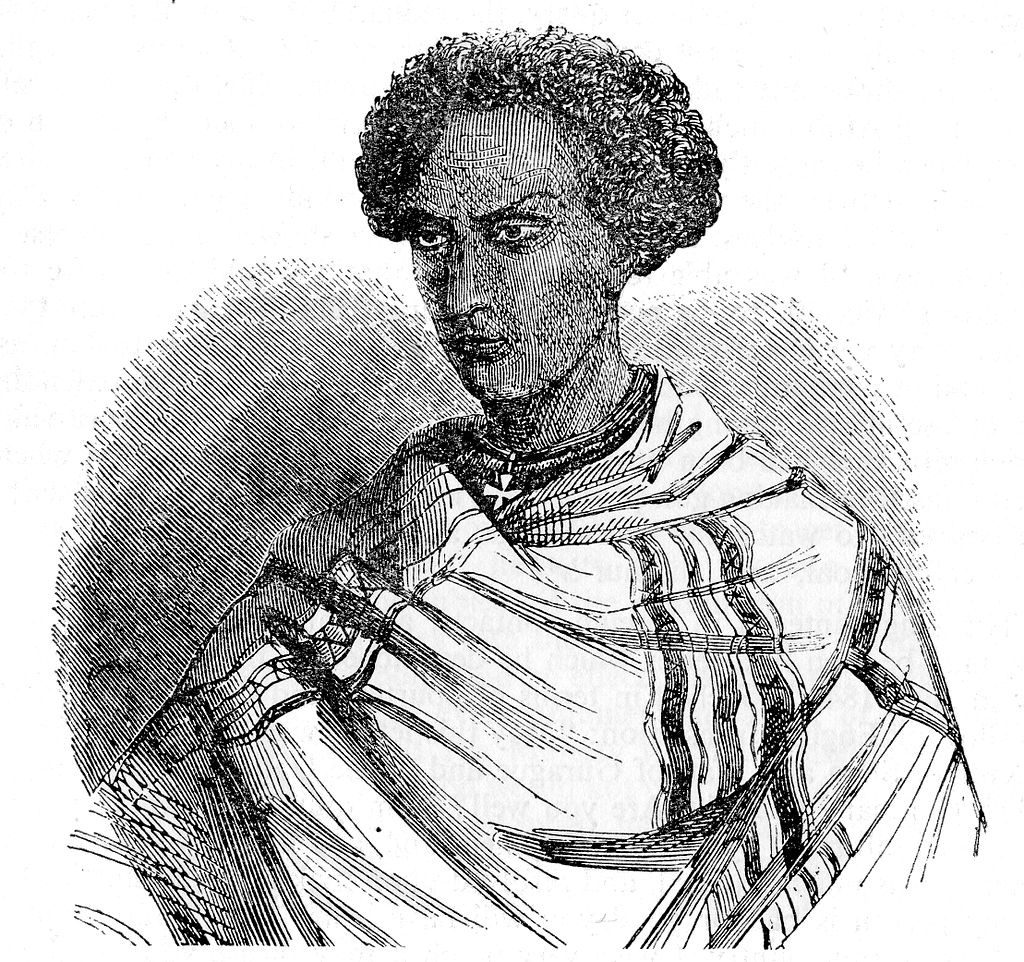
And his own views on the practice were more complex than we might expect. He disapproved of the trade, especially as slaves were frequent targets for Islamic conversion. As the British envoy Cornwallis Harris put it, he was “fully sensible of the possibility of dispensing with slavery,” but like any British MP or American founding father owning disposable human beings, he understood the harsh reality of market forces: slaves going out meant invaluable salt coming in—along with other precious imports.
It is fact that most of the exported slaves were Oromo or peoples from Sidamo, often sold by their own rulers after slaving raids or after they were sentenced for convenient petty crimes. Gurages were sold in significant numbers, while a good portion of the trade was kidnapped Christian children. And Christians weren’t above selling pagan or Muslim slaves, although we have conflicting reports that it was frowned upon. When there were more explicit prohibitions against Christians doing so, there was an easy workaround—simply use a Muslim go-between. Sometimes Greek and Armenians served as agents.
Girls were in demand more than boys, and a slave shipment could include as many as a hundred eunuchs. While there’s a dizzying set of competing statistics to consider, it doesn’t appear the trade was ever higher than 3,000 to 5,000 for any one port, but we have to keep in mind all our estimates were made by visiting Europeans, and their figures vary widely. While some of the enslaved were exported to Tigray and Massawa, many more were sent from Shoa to the coast. Most of those leaving Shoa were Christian or Muslim Gurages. All were on their way to the Middle East, either through the ports of Beylul in Eritrea, Tajura in Libya, and Zeila.
Unlike their West African brothers, the slaves heading east generally suffered less grim conditions and were rarely chained. Some Europeans claim to have seen slaves travel along, chatting amiably, even sometimes singing. But things depended entirely on who was handling transport, and we shouldn’t ever forget the dehumanizing practices that were in common use. In Basso, Gojjam, for instance, customers inspected the teeth of their “potential purchases” and casually groped the breasts of the girls and women for sale. The southern peoples who were enslaved and taken through Sudan got the worst of it, sometimes being chained and enduring filthy, tight quarters on ships sailing along the Nile.
So, yes, colorism can’t be easily or outright dismissed. But rather than just make blanket statements that imply Ethiopian slavery was somehow equivalent to the chattel slavery of Europeans (which it never was), it’s more useful to figure out why colorism became a factor. As with the West African slave trade, the ugly bigotry over skin tone may well have originated out of the initial contempt directed at conquered peoples who were the newest enemies and outsiders. In this all-too-human failing, Ethiopians have hardly been unique in the world.
Menelik and slaves
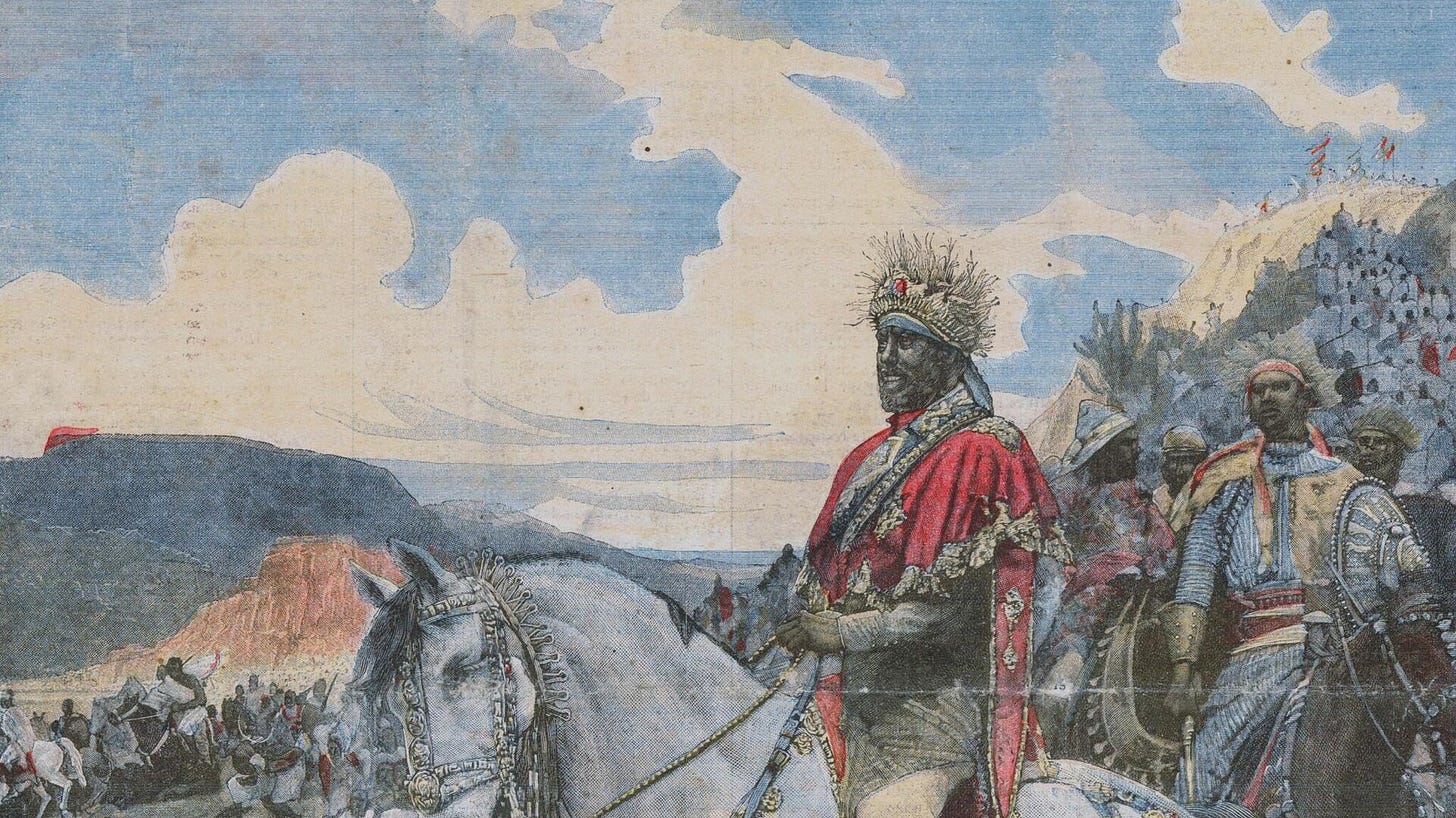
Every educated Ethiopian who knows their history can cite the harsh letter Menelik sent to Moti Aba Jifar of Jimma over enslaving Oromos. Does that settle things? Nope.
We can be sure thousands of people from Menelik’s brutal campaign for Walayta wound up as slaves—we know this because even an official chronicler tells us. The campaign itself saw revolting atrocities, even though Menelik gave orders that such acts weren’t to be committed. His word wasn’t enough to stop soldiers casually snatching babies away from captured mothers so their children wouldn’t “slow them down,” and female prisoners “forced to carry the severed genitals of their husbands and fathers.”
According to one French witness, the Ethiopian army took 18,000 slaves from Walayta, with close to 2,000 going to the emperor. This same Frenchman, by the way, accepted 11 slaves for himself.
Menelik projected an image for Europe that he was discouraging the slave trade, and at times he may have sincerely believed that it needed to be stamped out. But his own actions undermined his public resolve. In December of 1878, he’d written to England’s Anti-Slavery Society and promised, “I have abolished the slave trade in my whole kingdom and in its borders, for I am a Christian,” yet caravans of thousands of slaves threaded their way each year from Jimma to Shoa, bound for the port of Zeila and to the Middle East. A good portion of the captives were Gurage and Oromo.
Even when Menelik made another proclamation as emperor in 1889 to abolish the trade, his decree included an easy loophole—there could still be slaves captured in war (though their servitude was only supposed to last seven years). Besides the home market and the always hungry-for-more Middle East, there were plenty of European collaborators to keep the traffic moving and make fat profits, particularly the French, such as expatriate poet and gun runner Arthur Rimbaud in Harar.
Menelik’s anti-slavery measures grew real teeth after the Walayta campaign—perhaps because he was concerned about harder scrutiny from Europe where he hoped to find sympathizers in his case against Italy. Slave traders were sentenced to amputation, and those who castrated their newly acquired prisoners were executed.
Years later, in 1906, Menelik issued a new decree, promising “whoever I shall find selling [Oromo], I shall not only punish him with his property but shall also give him a bodily punishment.” But the trade didn’t go away. It simply moved underground, with the slave merchants taking enormous risks yet finding ways to disguise their traffic and no longer relying on the big open markets.
So, Menelik does not get off the hook for past transgressions, but we can’t see him as a complete villain either—in fact, far from it. He was a hardened warrior, yet the privations and bloody landscape after Adwa drained any urge for combat out of him, and so he was merciful to his Italian prisoners of war. He had owned slaves, had accepted the captured as slaves… and yet late in life, condemned it, not for show, but out of true moral commitment. By considering all of his conduct, we may perhaps understand what brought him to write his reprimands to Aba Jifar with such caring passion.
The 20th Century
The slave trade dragged on embarrassingly into the era of telegraph and automobile, and as Ethiopia continued to seek a place on the world stage, it became an acute national embarrassment. But as much as critics today want to treat the practice as “Ethiopia’s hidden shame,” the realities were too complicated for liberal (and especially white liberal) narratives. They still are.
There was a lot of yelling, for instance, from the British and French when Ethiopia wanted to join the League of Nations—until it turned out both their embassies in Ethiopia employed slaves. Fearing embarrassment, their diplomats rushed to free them in 1922, a situation that as writer C.F. Rey put it, apparently caused “bewilderment of the slaves, who could not understand what all the fuss was about…” Slavery was still going on then in Liberia, one of the League’s founding members. But Ethiopia joined the League anyway in 1923.
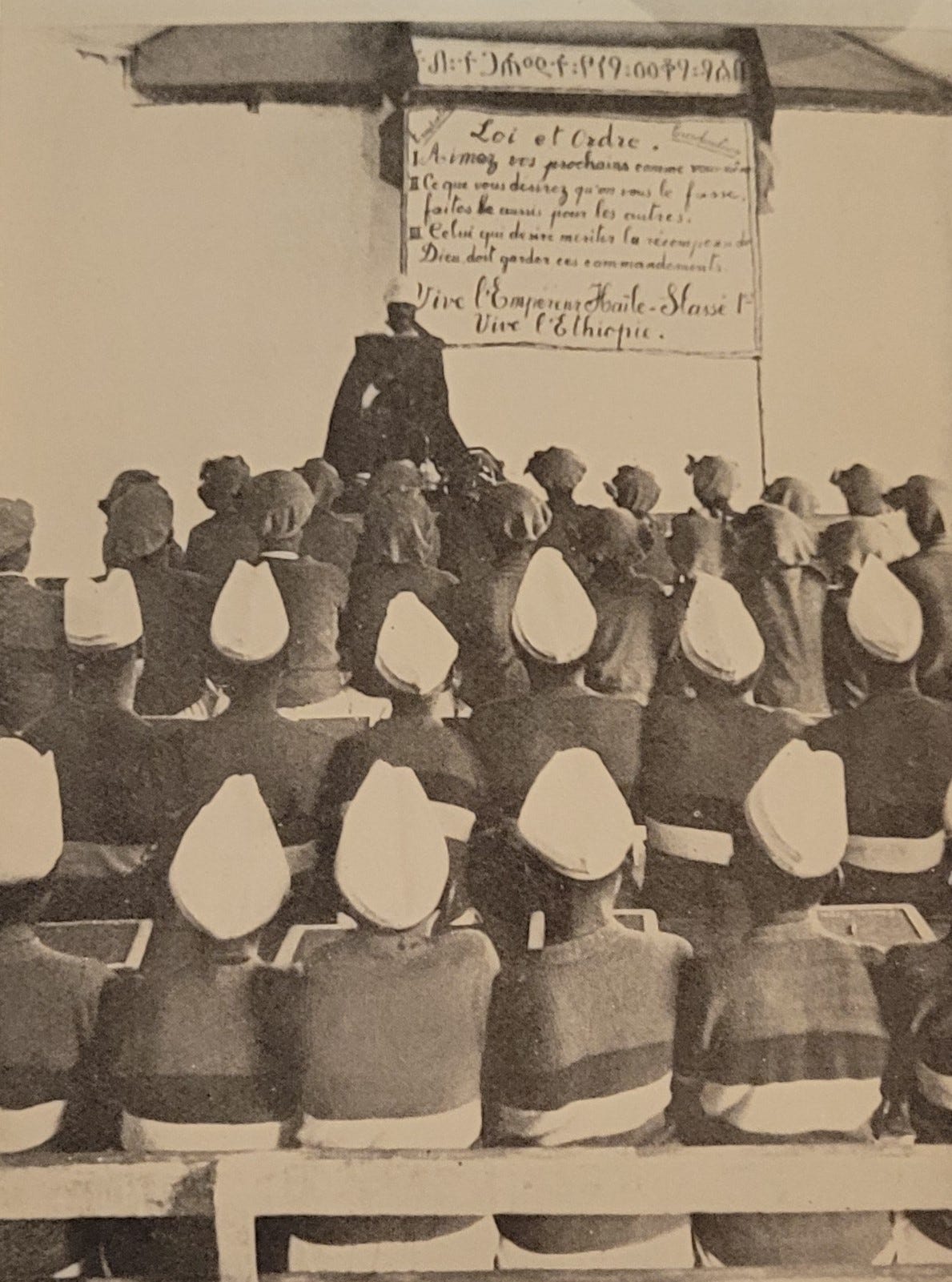
Ras Tafari had already begun taking steps to curb the trade and introduce reforms. A small school had been opened and was run at the time by Dr. Warqenah Eshate to teach former slaves and their children literacy, as well as skills such as weaving, tailoring, and carpentry, and one idea was to create a unique force of former slaves—trained at a military or police school—to hunt down gangs of shiftas. After becoming emperor, Tafari was powerful enough to take stronger measures to curtail the trade and free enslaved people, though slavery persisted on a smaller scale into the 1930s.
“I talked with slaves,” journalist Ladislas Farago wrote in his book, Abyssinia on the Eve, published in 1935. “They can still be met in Abyssinia but they are in no way down-trodden pariahs. Slavery is a trade like… a shoemaker’s. It is an occupation in Abyssinia and the word loses here the horror that it stirs up in European minds. An Abyssinian slave is of higher rank than his servant, for slaves have grown up for two or three generations with their masters, and it is not uncommon for a slaveowner to marry the daughter of one of his slaves, while her father remains under bondage. The slaves were happy then and did not want freedom. When the law of abolition was enforced in 1924, it perplexed both parties, but particularly the slaves who had been set free, for their liberation simply meant that, at a day’s notice, they were homeless.”
There is a lot to unpack here, and we should be careful with any narrative that suggests, just like the plantation owners of the U.S. or creepy apartheid advocates of South Africa, “Oh, they’re better off, they like servitude.” We’ve heard that line before, haven’t we? Yet it would also be a gross mistake to assume Farago was naïve—he was one of the most astute reporters covering Ethiopia at the time. And worse, to condescendingly assume that the slaves he spoke to weren’t capable of expressing their own interests and concerns.
I doubt you’ll find any of those banging on today about slavery in Ethiopia mention a bizarre incident that Farago also mentions in his book. Apparently, Arab slave dealers got wind of the reforms of 1924 and showed up in the country, eager to take advantage, “most of them making Gondar their base.” Farago claims they “did business on a huge scale.”
He continues: “Thousands of the liberated slaves sold themselves body and soul to these dealers who smuggled them across the frontier and transported them to Arabia… the Arabs never hesitated in breaking their promises to keep the slaves in good condition. The Black freight [sic] was packed in, man crushed against man, and whoever complained was thrown overboard. Frightful disease broke out and ravaged these miserable creatures, but the dealers made short work of their dead by hurling them into the sea.”
What became of those who survived? We don’t know. But where is the attention for them? For these historical victims who were willing to put themselves back into bondage? Better still, where’s the connective tissue of compassion for Ethiopians today who end up in horrible living situations and often detention when they try their luck at working in Saudi Arabia?
The slavery saga ends not so much with a bang, celebrating its abolition, but with grumbles.
The Italian Fascists, of course, claimed they invaded Ethiopia in 1935 to “civilize” the country and stamp out slavery. But their lofty proclamation to free the slaves didn’t go quite the way they planned, a point that General Emilio de Bono, a genuine sleazebag and later war criminal, conceded in his memoir of the war: “I am obliged to say that the proclamation did not have much effect on the owners of slaves and perhaps still less on the liberated slaves themselves,” he wrote in his memoir. “Many of the latter, the instant they were set free, presented themselves to the Italian authorities, asking, ‘And now who gives me food?’”
But when the Fascists were finally getting their asses handed to them by the Ethiopian Patriots and British forces in 1941, they rescinded their anti-slavery decree and brought it back. So much for civilization. Fortunately, slavery petered out after Black Shirts were marched out of caves and sent packing.
What then do we make of all this? Does slavery deserve to be examined as part of Ethiopia’s history. Of course, it does, like everything else. Openly. Candidly. Frankly. But with accuracy and sensible perspective. Consider how we needed more than 4,000 words just to cram in some essential and very basic details. Ethiopia has a luminous enough history and strong enough culture to face its legacy of what we now consider one of the evilest practices against human beings…especially when that same practice was being done around the world. Those who want to harp on this subject without context or balance rush to claim Ethiopians try to hide behind their “exceptionalism.”
It’s a tedious, petty taunt, the equivalent of the schoolyard, “There ain’t nothing special about you!” Only there is and always was. That Ethiopian slavery survived as long as it did was paradoxically because the country was never colonized by the Europeans, who would have surely imposed their more severe and despicable forms of slavery had they been successful. That certainly doesn’t make the Ethiopian brand “better” but it does make it different, and the study of history is about recognizing complexities.
In acknowledging the past, Ethiopians don’t have to adopt the same defensiveness as idiotic UK nationalists, who bluster, “We stamped out slavery!” (Yeah, you helped start the slave trade, British Dumbass.) At the same time, there is no point to getting sucked into propagandists’ efforts to shame. As much as the ,” look who’s talking! Harter’s article about denial was published about two months before the Guardian itself
By all means, feel free to shove this irony down its reporters’ throats the next time the paper wants to condescend to Africa.
And to be clear, there is nothing in Ethiopia’s slave legacy that is the “original sin” comparable to how white America has to think about reparations or the British occasionally think of apologizing for the Amritsar Massacre (yet never do). It is because slavery and the slave trade went beyond the mere institutions of the emperor and his rases. As we discussed earlier, you want to try that, you’ll have to throw blame at Oromo kings and chiefs and Adal sultans, too. And for all the indicting anecdotes of what I call “oral hearsay” being spread around today, I can steer you back to Farago’s account. Ethiopian slavery just isn’t that simplistic a narrative.
Nor should it be. Nor should any part of a country’s past. You have to work at it to find the answers.
But then history is for people who want to think, who don’t want answers merely fed to them through a quick video or social media post. It’s for those who are genuinely free in their mind, unshackled by assumptions and prejudices.
Jeff Pearce Historian, novelist, career surrealist. Author of Prevail, Lady With a Smoking Gun, Gangs in Canada, The Karma Booth, Winged Bull, and The Gifts of Africa.
